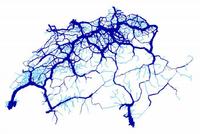|
|||||||||||
Structure and use of human activity spaces (Borlänge-Data)
Direction
ETH Zurich
Prof. Dr. Kay W. Axhausen
Institute for Transport Planning and Systems (IVT)
HIL F 31.3
Stefano-Franscini-Platz 5
8093 Zurich
Tel: + 41 44 633 39 43
Fax: + 41 44 633 10 57


Project Partner
Chaire de recherche opérationelle, Département de Mathématiques, EPF Lausanne
IVT Staff
Prof. Dr. Kay W. Axhausen
Stefan Schönfelder
Client
Duration
01.07.2002 – 30.06.2004
Abstract
Transport planning, psychology and geography conceive human behaviour in space to be constrained by the activity space of a person. In this activity space the travellers choose routes through time and space to meet their obligations, needs and desires. The travellers will try to choose these routes optimally, but they are constraint by their knowledge (mental map), their reasoning abilities and by the time and concentration they have available to construct and select the route.
In a wider sense, the activity space comprises both those locations of which a traveller has personal experience, as well as the knowledge space of locations, of which the traveller has second hand experiences through family, friends, books, films or other media. In the following, activity space refers to the first set of locations, those which a traveller has personally used.
Global Positioning System (GPS) - based tracking of individuals allows for the first time to study individual human activity spaces in detail, as such passive tracing is possible for many months and has no spatial boundaries. Based on an existing data set from Borlange, Sweden the project wants to address three fundamental behavioural questions:
- Size, structure and orientation of the individual activity spaces
- Frequency and amplitude of the rhythms of visits to different locations, including their competition
- Form of the rules of route choice behaviour
The answers to each of these questions will improve our ability to model and forecast traveller behaviour in transport planning models. In addition, they make valuable contributions to the discussions in fields, such as human navigation, environmental psychology or human geography and urban sociology.
The data set is created as part of a traffic safety project in Borlange. The project test the impacts of an in-car speed warning device, which informs the driver about violations of the local speed limit. 400 vehicles/drivers participate for at least 6 month each (up to a maximum of 15 months).
Wichtiger Hinweis:
Diese Website wird in älteren Versionen von Netscape ohne
graphische Elemente dargestellt. Die Funktionalität der
Website ist aber trotzdem gewährleistet. Wenn Sie diese
Website regelmässig benutzen, empfehlen wir Ihnen, auf
Ihrem Computer einen aktuellen Browser zu installieren. Weitere
Informationen finden Sie auf
folgender
Seite.
Important Note:
The content in this site is accessible to any browser or
Internet device, however, some graphics will display correctly
only in the newer versions of Netscape. To get the most out of
our site we suggest you upgrade to a newer browser.
More
information

